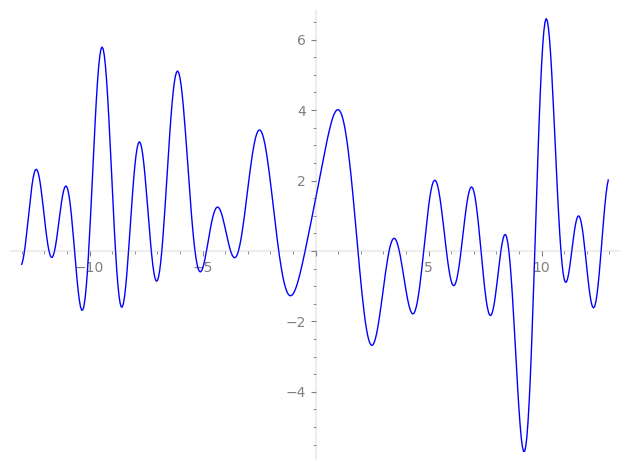| L(s) = 1 | + (0.866 − 0.5i)2-s + (0.499 − 0.866i)4-s + (−2.59 − 1.49i)5-s + (0.521 − 2.59i)7-s − 0.999i·8-s − 2.99·10-s + 0.776i·11-s + (3.39 − 1.20i)13-s + (−0.844 − 2.50i)14-s + (−0.5 − 0.866i)16-s + (1.17 − 2.02i)17-s − 2.95i·19-s + (−2.59 + 1.49i)20-s + (0.388 + 0.672i)22-s + (1.03 + 1.80i)23-s + ⋯ |
| L(s) = 1 | + (0.612 − 0.353i)2-s + (0.249 − 0.433i)4-s + (−1.16 − 0.670i)5-s + (0.197 − 0.980i)7-s − 0.353i·8-s − 0.947·10-s + 0.234i·11-s + (0.942 − 0.334i)13-s + (−0.225 − 0.670i)14-s + (−0.125 − 0.216i)16-s + (0.283 − 0.491i)17-s − 0.679i·19-s + (−0.580 + 0.335i)20-s + (0.0827 + 0.143i)22-s + (0.216 + 0.375i)23-s + ⋯ |
\[\begin{aligned}\Lambda(s)=\mathstrut & 1638 ^{s/2} \, \Gamma_{\C}(s) \, L(s)\cr =\mathstrut & (-0.976 + 0.216i)\, \overline{\Lambda}(2-s) \end{aligned}\]
\[\begin{aligned}\Lambda(s)=\mathstrut & 1638 ^{s/2} \, \Gamma_{\C}(s+1/2) \, L(s)\cr =\mathstrut & (-0.976 + 0.216i)\, \overline{\Lambda}(1-s) \end{aligned}\]
Particular Values
| \(L(1)\) |
\(\approx\) |
\(1.471176727\) |
| \(L(\frac12)\) |
\(\approx\) |
\(1.471176727\) |
| \(L(\frac{3}{2})\) |
|
not available |
| \(L(1)\) |
|
not available |
\(L(s) = \displaystyle \prod_{p} F_p(p^{-s})^{-1} \)
| $p$ | $F_p(T)$ |
|---|
| bad | 2 | \( 1 + (-0.866 + 0.5i)T \) |
| 3 | \( 1 \) |
| 7 | \( 1 + (-0.521 + 2.59i)T \) |
| 13 | \( 1 + (-3.39 + 1.20i)T \) |
| good | 5 | \( 1 + (2.59 + 1.49i)T + (2.5 + 4.33i)T^{2} \) |
| 11 | \( 1 - 0.776iT - 11T^{2} \) |
| 17 | \( 1 + (-1.17 + 2.02i)T + (-8.5 - 14.7i)T^{2} \) |
| 19 | \( 1 + 2.95iT - 19T^{2} \) |
| 23 | \( 1 + (-1.03 - 1.80i)T + (-11.5 + 19.9i)T^{2} \) |
| 29 | \( 1 + (0.541 - 0.937i)T + (-14.5 - 25.1i)T^{2} \) |
| 31 | \( 1 + (6.31 - 3.64i)T + (15.5 - 26.8i)T^{2} \) |
| 37 | \( 1 + (5.95 - 3.43i)T + (18.5 - 32.0i)T^{2} \) |
| 41 | \( 1 + (9.81 + 5.66i)T + (20.5 + 35.5i)T^{2} \) |
| 43 | \( 1 + (2.64 + 4.58i)T + (-21.5 + 37.2i)T^{2} \) |
| 47 | \( 1 + (7.35 + 4.24i)T + (23.5 + 40.7i)T^{2} \) |
| 53 | \( 1 + (2.30 + 3.99i)T + (-26.5 + 45.8i)T^{2} \) |
| 59 | \( 1 + (-3.28 - 1.89i)T + (29.5 + 51.0i)T^{2} \) |
| 61 | \( 1 - 13.3T + 61T^{2} \) |
| 67 | \( 1 - 5.34iT - 67T^{2} \) |
| 71 | \( 1 + (-3.56 + 2.05i)T + (35.5 - 61.4i)T^{2} \) |
| 73 | \( 1 + (6.95 - 4.01i)T + (36.5 - 63.2i)T^{2} \) |
| 79 | \( 1 + (1.49 - 2.58i)T + (-39.5 - 68.4i)T^{2} \) |
| 83 | \( 1 + 4.25iT - 83T^{2} \) |
| 89 | \( 1 + (-7.54 + 4.35i)T + (44.5 - 77.0i)T^{2} \) |
| 97 | \( 1 + (-2.45 + 1.41i)T + (48.5 - 84.0i)T^{2} \) |
| show more | |
| show less | |
\(L(s) = \displaystyle\prod_p \ \prod_{j=1}^{2} (1 - \alpha_{j,p}\, p^{-s})^{-1}\)
Imaginary part of the first few zeros on the critical line
−8.849620320700476970888230465915, −8.273283692574551258748929956820, −7.26710500432584592488908233038, −6.80268837432682272108388287000, −5.33478573618369000189812372982, −4.82488751009202129870738772817, −3.75915667780200894167709633351, −3.41220514176807962568200972508, −1.62942032098738762032126933989, −0.46214250005218272474118441090,
1.87608997159966045442545504441, 3.25347127366621480835209501984, 3.70337324900970013967416775836, 4.78349910838988800552617992723, 5.78895974379451743604333371608, 6.43649381358679377062394783634, 7.32062560649842108209115670025, 8.200542124471349907052543017614, 8.552017998653158494385689965238, 9.700153278579697520850564161304

